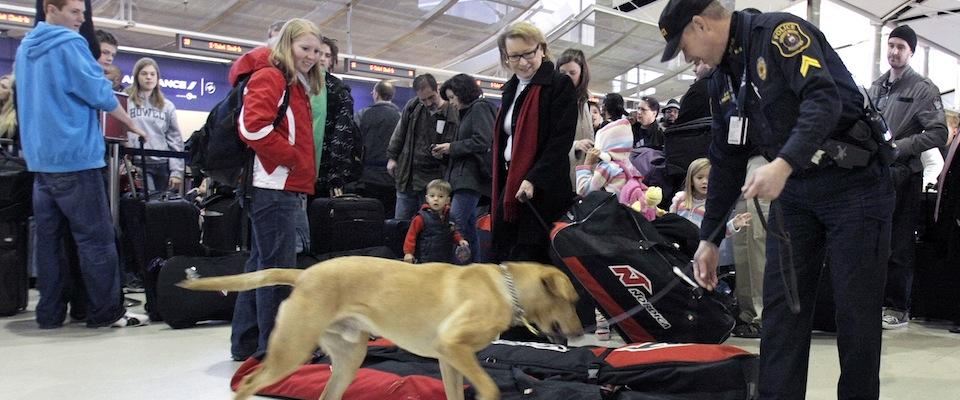Berkeley graduate students discover a true calling for two orphaned dogs.
As Allison Bidlack, Ph.D. ’07, bounced a tennis ball in front of the cages of an animal shelter, she caught sight of an energetic, brown pit bull/terrier mix named Seth. It was one of many days in 2004 that Bidlack spent scouring pounds, searching for just the right reaction in the dogs. Intrigued by Seth’s energy, she took him out of his kennel to play. He eagerly fetched a ball, a stuffed animal, a Frisbee, and a rope toy.
But what sold her on Seth was how he searched tirelessly for a tennis ball hidden under brush. “Many dogs will fail at this point because they just forget about the ball,” she said. Seth was different. “He passed all the tests of attention and perseverance,” she said. That’s how Seth left his life as a pound dog to become a wildlife detection dog, one of a growing number of animals used in conservation work.
“I think the real benefit that dogs can have is when you’re working with rare species,” said Bidlack. “If you are trying to find, say, fishers or wolverines, or kit foxes, it’s much harder for a human being to locate those scats.” She became interested in the idea as a graduate student in Berkeley’s Department of Environmental Science, Policy, and Management, when she heard that Sarah Reed, Ph.D. ’07, had enlisted the help of a canine.
Reed was designing research on the effects of urban development on Bay Area carnivores—coyotes, bobcats, gray foxes, and red foxes. She began to compare various wildlife survey methods, such as remote cameras.
“Scat,” Reed concluded, “was really the right way to go.” By collecting and analyzing DNA in the animals’ feces, she could identify which carnivore had left the deposit and where the animal had been. She considered hiring human field assistants to hunt for animal deposits. But then she heard about wildlife detection dogs and quickly realized the advantages. Whereas humans rely on sight to spot excrement, dogs’ keen sniffing capabilities can detect scat at up to five times the distance and in less time. The dogs can also distinguish among various species’ droppings.
Reed teamed up with Working Dogs for Conservation, a nonprofit group based in Montana that provides trained handlers to conservation projects around the globe, including a recent project in China tracking moon bears. “I really liked their philosophy of working with dogs that were rescued from shelters,” said Reed, who was trained in Montana by WDC cofounder and associate director Aimee Hurt. Reed had checked out more than 300 dogs before she found Maggie, a Labrador retriever mix.
And Bidlack’s instincts about Seth turned out to be right: Out of a few finalists, he proved to be top dog. “Seth just had all the right attributes; he was smart and completely focused,” Bidlack said. “He just got it.”
It took approximately 12 weeks each to train Maggie and Seth, rewarding the animals with a play session whenever they found the right feces. “If you’re working with the right dog,” Bidlack said, “they almost train themselves because they are so enthusiastic.”
But Reed wasn’t ready to dive in just yet. “[Reed] is very careful about assumptions and statistical rigor,” said Bidlack, “And so she started thinking about whether and how the dogs should be calibrated.”
At Hopland Research and Extension Center in Mendocino County, Reed and Bidlack tested Maggie and Seth in a variety of weather conditions. The researchers took excrement of the target species—donated by local zoos and animal rehab centers—and placed it around a pasture. Then they walked the dogs along a transect line. Their final study, published in the Journal of Wildlife Management, reported that the dogs could accurately detect feces at a distance of 33 feet, more than 75 percent of the time.
The dogs’ performance declined most after several weeks of rain. Reed and her colleague speculated that rainfall decomposed the deposits. Interestingly, high temperatures enabled Maggie to detect more scat, while they hindered Seth’s abilities. Reed thinks it’s probably because Seth has a lower tolerance for heat.
The findings underscore the fact that each dog is unique, with its own strengths and weaknesses. Reed hopes the study will encourage others who are using detection dogs to similarly test their animals’ capabilities and design surveys that maximize the abilities of each individual animal.
The fact that the dogs are living creatures brings up another question: Do they ever get tired of playing with the ball? “They love their ball,” Hurt replied by email. “They want it on the sixtieth toss of the day as much as the first. If you have to keep upping the reward, then the dog doesn’t really want the job.”
After the studies, both Maggie and Seth were retired and became family pets.




















